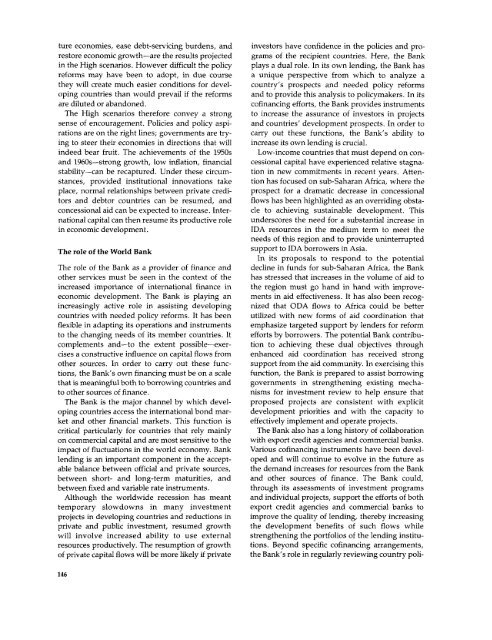World Bank Document
World Bank Document
World Bank Document
Create successful ePaper yourself
Turn your PDF publications into a flip-book with our unique Google optimized e-Paper software.
ture economies, ease debt-servicing burdens, and investors have confidence in the policies and prorestore<br />
economic growth-are the results projected grams of the recipient countries. Here, the <strong>Bank</strong><br />
in the High scenarios. However difficult the policy plays a dual role. In its own lending, the <strong>Bank</strong> has<br />
reforms may have been to adopt, in due course a unique perspective from which to analyze a<br />
they will create much easier conditions for devel- country's prospects and needed policy reforms<br />
oping countries than would prevail if the reforms and to provide this analysis to policymakers. In its<br />
are diluted or abandoned.<br />
cofinancing efforts, the <strong>Bank</strong> provides instruments<br />
The High scenarios therefore convey a strong to increase the assurance of investors in projects<br />
sense of encouragement. Policies and policy aspi- and countries' development prospects. In order to<br />
rations are on the right lines; governments are try- carry out these functions, the <strong>Bank</strong>'s ability to<br />
ing to steer their economies in directions that will increase its own lending is crucial.<br />
indeed bear fruit. The achievements of the 1950s Low-income countries that must depend on conand<br />
1960s-strong growth, low inflation, financial cessional capital have experienced relative stagnastability-can<br />
be recaptured. Under these circum- tion in new commitments in recent years. Attenstances,<br />
provided institutional innovations take tion has focused on sub-Saharan Africa, where the<br />
place, normal relationships between private credi- prospect for a dramatic decrease in concessional<br />
tors and debtor countries can be resumed, and flows has been highlighted as an overriding obstaconcessional<br />
aid can be expected to increase. Inter- cle to achieving sustainable development. This<br />
national capital can then resume its productive role underscores the need for a substantial increase in<br />
in economic development.<br />
IDA resources in the medium term to meet the<br />
needs of this region and to provide uninterrupted<br />
The role of the <strong>World</strong> <strong>Bank</strong><br />
support to IDA borrowers in Asia.<br />
In its proposals to respond to the potential<br />
The role of the <strong>Bank</strong> as a provider of finance and decline in funds for sub-Saharan Africa, the <strong>Bank</strong><br />
other services must be seen in the context of the has stressed that increases in the volume of aid to<br />
increased importance of international finance in the region must go hand in hand with improveeconomic<br />
development. The <strong>Bank</strong> is playing an ments in aid effectiveness. It has also been recogincreasingly<br />
active role in assisting developing nized that ODA flows to Africa could be better<br />
countries with needed policy reforms. It has been utilized with new forms of aid coordination that<br />
flexible in adapting its operations and instruments emphasize targeted support by lenders for reform<br />
to the changing needs of its member countries. It efforts by borrowers. The potential <strong>Bank</strong> contribucomplements<br />
and-to the extent possible-exer- tion to achieving these dual objectives through<br />
cises a constructive influence on capital flows from enhanced aid coordination has received strong<br />
other sources. In order to carry out these func- support from the aid community. In exercising this<br />
tions, the <strong>Bank</strong>'s own financing must be on a scale function, the <strong>Bank</strong> is prepared to assist borrowing<br />
that is meaningful both to borrowing countries and governments in strengthening existing mechato<br />
other sources of finance.<br />
nisms for investment review to help ensure that<br />
The <strong>Bank</strong> is the major channel by which devel- proposed projects are consistent with explicit<br />
oping countries access the international bond mar- development priorities and with the capacity to<br />
ket and other financial markets. This function is effectively implement and operate projects.<br />
critical particularly for countries that rely mainly The <strong>Bank</strong> also has a long history of collaboration<br />
on commercial capital and are most sensitive to the with export credit agencies and commercial banks.<br />
impact of fluctuations in the world economy. <strong>Bank</strong> Various cofinancing instruments have been devellending<br />
is an important component in the accept- oped and will continue to evolve in the future as<br />
able balance between official and private sources, the demand increases for resources from the <strong>Bank</strong><br />
between short- and long-term maturities, and and other sources of finance. The <strong>Bank</strong> could,<br />
between fixed and variable rate instruments.<br />
through its assessments of investment programs<br />
Although the worldwide recession has meant and individual projects, support the efforts of both<br />
temporary slowdowns in many investment export credit agencies and commercial banks to<br />
projects in developing countries and reductions in improve the quality of lending, thereby increasing<br />
private and public investment, resumed growth the development benefits of such flows while<br />
will involve increased ability to use external strengthening the portfolios of the lending instituresources<br />
productively. The resumption of growth tions. Beyond specific cofinancing arrangements,<br />
of private capital flows will be more likely if private the <strong>Bank</strong>'s role in regularly reviewing country poli-<br />
146

















